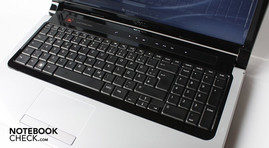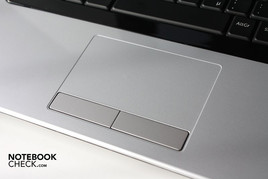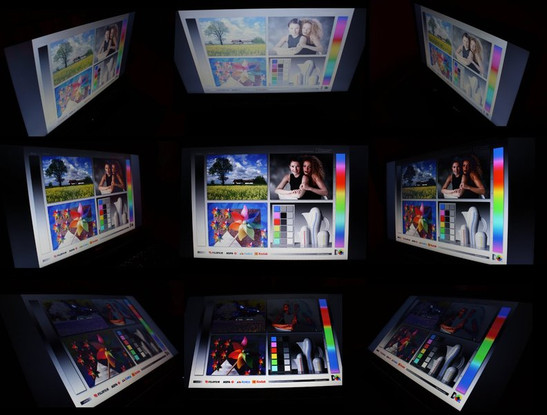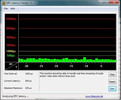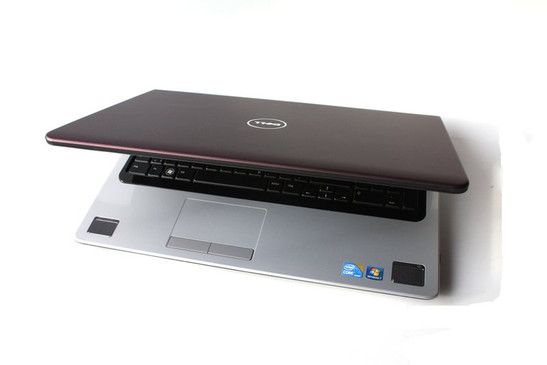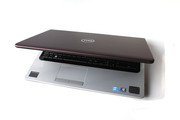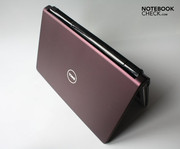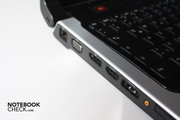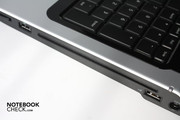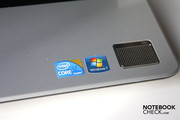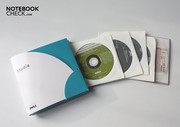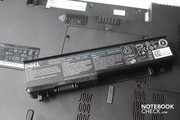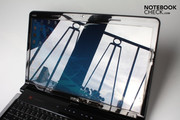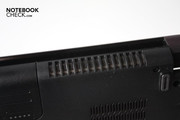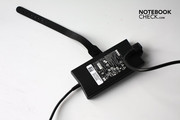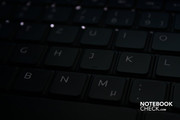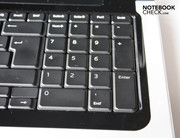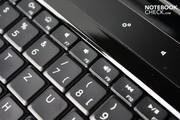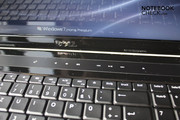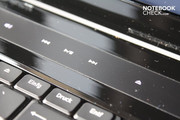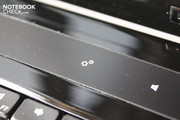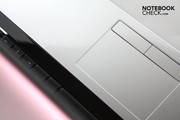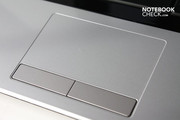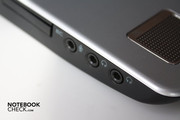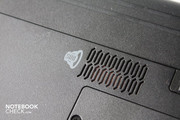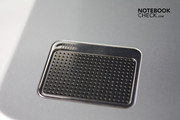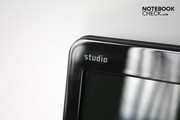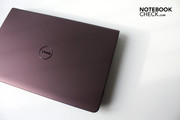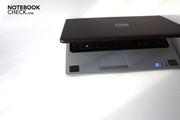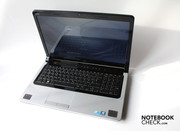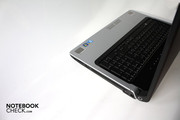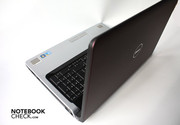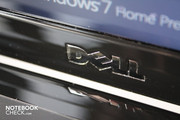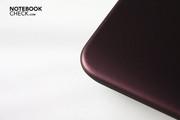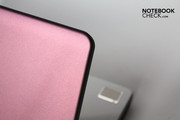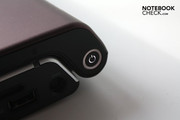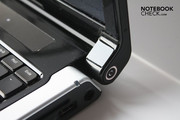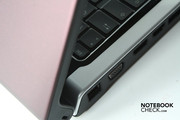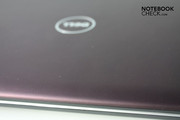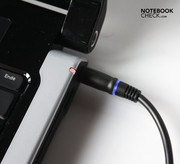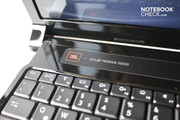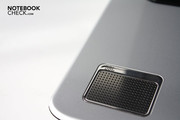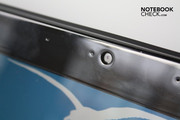Review Dell Studio 1747 Notebook
Twenty-One or "Seventeen and Four"
Those who choose Dell's Studio range, expect design, quality and of course computing power for multimedia and middle class gaming. The Studio 1747 is the biggest representative of the Studio range with a 17.3 inch display and having a four core processor from Intel's Core i7 family. The family members have often been hot-headed - what are the prospects for the Studio 1747?
Dell has furnished its middle class between low-priced Inspiron notebooks and fast XPS notebooks with the Studio range. The notebooks are supposed to talk multimedia users into buying a Dell laptop available in 15.4 and 17.3 inches. The entry into Dell's Studio 17's world starts at a list price of 688 euro and with a Pentium Dual Core T4300 and Radeon 4570. If you choose the fastest alternative, the most expensive warranty package and all software options, the price for the configuration with an Intel Core i7 820QM, Radeon 4650, an 8 GByte RAM, a hard disk memory of one terabyte and a FullHD display goes up to 3788 euro. Without shipping and supplies.
Our configuration was available for a list price of 1287 euro. An Intel Core i7 720QM processor with 1.6 - 2.8 GHz and four computing cores, a Radeon 4650 graphic card with a 1 GByte dedicated memory, a 4 GByte RAM and a 500 GByte hard disk memory was included in our prototype.
Case
In opposition to its forerunners, the new Dell Studio 17 has been changed in a few design points, for instance the loudspeakers are now in the wrist-rest. As you could select case lids designed by artists for the older models and even make a donation for a good cause with that, there are only plain colored display lids available for the Dell Studio 17.
The lid is black with a slight pattern in the standard configuration. Additionally there are five more striking colors available: pink, red, blue, purple and green. All these alternatives are covered with a micro-satin surface that has quite pleasant feel – like a mixture of rubber and textile. A chromed metal Dell logo is in the center.
The Studio 17 notebooks all look alike inside: glossy black plastic around the display, the white imprint "Studio" in the upper left and again a metallic Dell logo in the bottom center. Furthermore, the black plastic has a multimedia bar above the keyboard and thus creates a narrow keyboard bezel. The rest of the inside is dominated by a light gray plastic that also has a high-gloss finish. Both loudspeakers, which are submerged into the wrist-rest's left and right and protected by a perforated and chromed metal grid, are also striking.
All of that has been very excellently crafted and feels good. The light gray plastic that the wrist-rest is made of proves to be a good choice. Because of the light color, fingerprints only become evident on the high-gloss surface in bright light. The micro-satin surface presents itself as being fairly unsusceptible for smudge. Only greasy finger leave dark spots, which are easily removed, though.
The display hinges are both on the very left and right and are nicely designed. They keep the screen very tight in place so that you can't open the notebook single-handedly or even just tilt it even more towards the back despite the high total weight. A teetering is almost completely missing. By the way, the display hinges' design prevents the screen from being opened more than 45 degrees from the perpendicular.
Connectivity
Because of the display design, Dell can't place any connections on the back. And although the Americans also opt out on building ports onto the front, the connectivity in the Studio 1747 is quite impressive.
So, on the left from front to back there are: two 3.5mm headphone-outs, one microphone-in, an ExpressCard slot, an antenna socket for a TV tuner, which didn't work in our prototype as it didn't have a tuner, though. Further, a combined eSATA - USB 2.0 connection, an HDMI port, a display port, a VGA socket, a LAN port and a slot for a Kensington lock built into the hinge.
On the right, also from front to back are: a 4-pin Firewire connection, the 8-in-1 cardreader, which can read SD, MMC, xD, SDHD, SCHC, Memory Stick, Memory Stick Pro and SDIO cards. A USB 2.0 port, the slot-in DVD burner, diagonally underneath that a further USB port, followed by the DC-in and the power switch built into the hinge.
Dell, especially in the display connection alignment, offers everything that is currently available for the consumer, with exception of a DVI port. Dell even builds in a, at the moment mainly professionally used, display port. Firewire is onboard and a second headphone connection is great for all those who don't want to enjoy a movie on the big display alone. The eSATA-USB 2.0 combo port has a Power Share function as a small gimmick, with which portable devices can be charged via the USB port even in a turned off state.
The interfaces have also been positioned favorably, whereas a further USB connection on the left wouldn't have been a bad idea. Thus, users who want to connect an external hard disk via eSATA can only attach a USB mouse on the right. Additionally, the USB port underneath the slot-in drive is unsuitable for thicker USB sticks because they might obstruct the drive and, in the worst case, could scratch the DVD
Because Dell has placed the display ports in the rear area, lefties should also be well-capable of using a USB mouse. However, the headphone and microphone cables could cause problems on the front left side. Placing these on the front would have loosened the condition additionally.
Dell exclusively builds in WLAN over a Dell Wireless 1397 card that supports the 802.11 b and g standard as wireless interfaces. If you'd like to have the brand new standard 802.11 n supported, you'll have to invest 20 euro in a Dell Wireless 1520 card as an optional supply. The cheaper card suffices for current DSL connections, though. Mobile internet via HSDPA is also optionally available for a surcharge of 120 euro.
The DVD burner comes from LG electronics and hasn't got a drive tray. Instead it retracts the disks via slot-in. This gives the case additional stability and looks high-end, but is a bit loud.
Software
Dell uses Windows 7 Home Premium as the operating system, whereas the Professional or Ultimate is available for a surcharge. We almost have to praise the fact that Dell has included the operating system as a recovery DVD. Other manufacturers hide the system on the hard disk and force the user to burn a DVD.
Thus, you can build in another hard disk right away and don't have to worry about the included operating system. Dell also includes a DVD for the installed applications and one for the drivers so that you don't have to reinstall them with a new installation if you don't want to.
There is also a full version of Microsoft Works 9.0 included. If you want to buy MS Office, you can do that on Dell's homepage for a surcharge. Merely the trial version is installed in the basic configuration, which deactivates itself after a few starts but at the latest after 30 days. At least, McAfee's Security Center lasts for 15 months before you have to buy a new license. But this was only due to a special action by Dell in the testing period. Besides that, Dell also included Roxio Burn and Power DVD DX.
Overall, agreeably few trial versions and many useful programs have only been installed. Whilst other manufacturers stuff their desktops with all kinds of bloatware, Dell is pleasantly restrained in this term.
Input Devices
Keyboard
The keyboard has a separate numerical block, which isn't surprising in view of the case's width. Although Dell has made the keys quite big, there is a noticeable gap between the keys because of the slightly beveled edges, which makes typing easier. The keyboard in our configuration alternative additionally has a white backlight that can be turned off with a push of a button but is a very handy feature in dark surroundings.
The key stroke is solid and very audible. A short key stroke allows for fast typing. Typing is generally simply accomplished even if the keyboard doesn't sit quite tight and yields easily in some areas.
The keys F1-12 have been made to be combined with the "FN" key so that these keys now primarily trigger special functions, like display brightness control or are used as multimedia keys. Combinations such as Alt+F4 still work, though.
An extra control bar that has touch sensitive buttons is also above the keyboard and also has volume control, multimedia buttons and an eject button for the DVD drive.
Moreover, Dell has built-in a chic light effect for the white backlit keyboard. The white light runs from the right to the left and back again at system start before the keys are permanently lit.
Touchpad
The touchpad has a slightly roughened surface and is underneath the space bar, thus it's been moved a bit to the left due to the separate numerical block. It has been slightly submerged and feels a lot rougher than the rest of the surrounding wrist-rest area for a better differentiation. But the finger glides smoothly over the surface anyway, making the touchpad to a good mouse substitute.
There are scroll bars on its right and lower edge that aren't limited optically or haptically but are indicated by a symbol on the mouse cursor. The multi-touch gestures that can be triggered by placing a second finger on the touchpad are also shown. You can, for instance, magnify symbols on the desktop by expanding the fingers or rotate pictures in image editing programs with circular movements. The gestures are understood and executed reliably by the touchpad in most cases.
Dell has treated the Studio 1747 to two smooth, silver shining touchpad keys. They have quite a soft pressure point, which makes them quiet but they also have an indistinct feel and lack a clear feedback. However, they respond reliably when the key is pressed.
Display
The 17.3 inch display presents 1600 x 900 pixels and has thus an aspect ratio of 16:9. That's well suitable for games and movies but makes it necessary to scroll frequently in horizontal documents.
Colors look brilliant and luminous, whereas black areas appear subjectively rather as a dark gray and not very vivid. This is reflected in the test results, which have a good average illumination of 231.6 cd/m2 but only a homogenous illumination of 79 percent and an average black value of 1.3 cd/m2, at most.
| |||||||||||||||||||||||||
Brightness Distribution: 79 %
Center on Battery: 244 cd/m²
Contrast: 188:1 (Black: 1.3 cd/m²)
Additionally, the screen has been treated with a reflective coating, which is responsible for the brilliant colors on the one hand but makes use in bright rooms or even outside difficult. Working in such surroundings is difficult because of reflections on the glossy finish, as you usually only see the reflection instead of the display content. Furthermore, reflections make it strenuous for the eyes to focus in the long run.
The viewing angles are really good towards the sides so that even several people can watch a movie beside each other on the Studio 1748 without the persons on the outer sides having to accept color deviations. The viewing angles are alright upwards and downwards, but if the screen is tilted too much, an significantly brighter, respectively darker image is seen.
Performance
If you choose the new Dell Studio 17 in our configuration alternative, you'll probably be focusing on the Core i7 processor. The 720QM is a quad-core processor with a 1.6 to 2.8 GHz clock rate and a 6 MByte L3 cache. The processor chooses if one core with a higher rate or several cores with a lower rate is better for the performance depending on the application and adapts the number of active cores and their clock rate optimally. This automatic is of course also used for energy saving in a laptop processor.
Dell builds in a Radeon HD 4650 from ATI with a 1024 MByte dedicated graphic memory. This middle class graphic card should be enough for current games when the display's native resolution is set to a medium detail level.
Dell heralds itself to have built-in the "fastest processor on earth". Naturally, that isn't quite the truth because apart from the strongest Core i7 alternative, which Dell doesn't offer, there are still high performance computers.
But, of course, the Core i7 720QM provides overwhelming performance rates and is one of the fastest processors that is currently built into consumer notebooks. 5030 points in PCMark Vantage and 9626 points in multi-core rendering of Cinebench R10 add up to a rate of a respectable 91% in application performance. Thus, even demanding tasks, such as professional image editing and video cutting should be possible on Dell's Studio 1747.
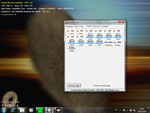
There are user reports in the forum on Hardwareluxx's site that the Core i7 in their Dell Studio 1747 clocks down to 1.3 GHz under greater load. We wanted details and put the notebook to a stress test: 12 hours Furmark and the processor benchmark, Prime95, to push the graphic card and the processor to their absolute limits.
Although the tool, Speedfan, didn't indicate a clock rate reduction after 12 hours, the immediately following 3DMark06 showed that the Dell Studio 1747's performance capability does decrease strongly. A total of 5045 points are over 2000 less than in the test in normal conditions. The CPU performance rate is almost halved with 1745 points.
This is probably due to the undersized adapter that can't supply all components under full load anymore. That's why Dell sends a 130 watt adapter for free upon telephone request, with which the problem should be solved. The latest inquiry by Dell disclosed that it's recommended to wait for the bios update A04, which should be released on January 13th and according to Dell, remedies the problem.
| PCMark Vantage Result | 5030 points | |
Help | ||
Seagate's fast hard disk, which stores 500 GBytes and rotates with up to 7,200 revolutions per minute, definitely also contributes to the good performance rates. However, we noticed strange breakdowns of the transfer rates in the benchmark with our tool, HDTune, which didn't fail to appear even after repeating the benchmarks several times. We didn't notice these breakdowns in the practical test, so copying files, though. The system copied the files quickly and with a constant velocity.
The HDTune benchmark established an overall average transfer rate of 73.2 MBytes per second and an access rate of 17.7 milliseconds.
| 3DMark 2001SE Standard | 28828 points | |
| 3DMark 03 Standard | 19248 points | |
| 3DMark 05 Standard | 13302 points | |
| 3DMark 06 Standard Score | 7149 points | |
Help | ||
We first used the synthetic benchmarks of the 3DMark range for assessing the gaming performance. The oldest benchmark, 3DMark2001, of course ran through our system in no time at all, finished with a rate of 28828 points and places itself on the top of the middle field. The notebook also reveals very good rates of 13302 respectively 7149 in the more mainstream benchmarks, like 3DMark05 or 3DMark06.
Then the Studio 1747 is ushered to the world of real games where it has to show its capabilities. We tested with the cutting-edge "Modern Warfare 2" and the equally still young "Risen". The quite demanding in high details "Anno 1404" and the older games "Race Driver: GRID" and "Call of Duty 4" join in.
As expected, the notebook didn't have any problems in very low resolutions, even with the latest games: We achieved an average of 134 frames even with "Modern Warfare 2". When the resolution is turned up a bit to medium details, a still well-playable 41 frames are still left. A further increase of details only results in a small reduction of the average frame rate to 35 frames.
Older games like "Racedriver GRID" or "Call of Duty 4" even stay playable in the highest details with 52 respectively 45 frames. The graphic card finds its limits in "Anno 1404" in very high details and a resolution of 1280x1024 and in "Risen" in very high details and 1366x768. 27 or 21 frames on average are still playable but aren't really any fun anymore.
The Studio 1747 is quite impressive corresponding to its claim as a middle class gamer. Especially "Modern Warfare 2" benefits evidently from the Core i7's four computing cores. The frame rate of the other games is also slightly higher than in notebooks with a Core 2 Duo processor, even if the differences are significantly less there. You can play in the native resolution of 1600x900 pixels but then you have to reduce the details eminently.
In particular, the graphic card inhibits gaming. An ATI Radeon 4830 or a Geforce GTS 260M would have been the better choice. But the Dell Studio 1747 in this configuration bids significantly more gaming power in this configuration than many other multimedia notebooks anyway. We award that with a rating of 88% for gaming performance.
| Call of Duty 4 - Modern Warfare | |||
| Resolution | Settings | Value | |
| 1280x1024 | high, 4xAA | 45 fps | |
| 1024x768 | med, 0xAA | 82 fps | |
| 800x600 | low, 0xAA | 130 fps | |
| Racedriver: GRID | |||
| Resolution | Settings | Value | |
| 1280x1024 | , 2xXMSAAAA | 43 fps | |
| 1024x768 | , 0xAA | 52 fps | |
| 800x600 | , 0xAA, 0xAF | 98 fps | |
| Anno 1404 | |||
| Resolution | Settings | Value | |
| 1280x1024 | very high, 0AA, 4AF | 27 fps | |
| 1024x768 | low, 0AA, 0AF | 104 fps | |
| Risen | |||
| Resolution | Settings | Value | |
| 1366x768 | all on/high, 4xAF | 21 fps | |
| 1024x768 | all on/med, 2xAF | 66 fps | |
| 800x600 | all off/low, 0xAF | 72 fps | |
| CoD Modern Warfare 2 | |||
| Resolution | Settings | Value | |
| 1366x768 | all on/high vsync off, high textures, 4xAA | 35 fps | |
| 1024x768 | all on/med vsync off, normal textures, 2xAA | 41 fps | |
| 800x600 | all off/low vsync off, low textures, 0xAA | 134 fps | |
DPC Latencies
We also check DPC latencies, which can lead to communication problems with devices like external sound cards or external graphic cards. That is, too high latencies jeopardize the real time communication with these devices. However, the Dell Studio 1747 is exemplary here. All deflections stay within a green field and thus it should be possible to also work with external components without further ado.
Emissions
System Noise
If the Dell Studio 1747 has actually been a very good notebook for the multimedia friend or occasional gamer up till now, we now come to that point that has always ruined the Studio notebook's very good ratings: the emissions.
The noise emissions were even still reasonable. The fan rotated quietly and was barely audible in idle mode: we assessed an average of 31.8 dB(A) and a somewhat louder 36.6 dB(A) at maximum. The hard disk integrates itself very well and also stays barely audible with 33.5 dB(A). In return, the DVD drive attracts disagreeable attention with its loud feeding mechanism and its quite loud operating noise of 38.6 dB(A).
It's even louder under load. We assessed a maximum of 46 dB(A) and that is quite audible. The fan reached this volume in several stages and then stays constant operating under load. The strong processor and the graphic card take their toll. But especially in view of the good performance values, you can live with the system noise.
Noise level
| Idle |
| 31.8 / 31.8 / 36.6 dB(A) |
| HDD |
| 33.5 dB(A) |
| DVD |
| 38.6 / dB(A) |
| Load |
| 44.2 / 46 dB(A) |
 | ||
30 dB silent 40 dB(A) audible 50 dB(A) loud |
||
min: | ||
Temperature
This looks different for the temperatures. They reach unreasonably high rates. The temperatures can rise to 38.2 degrees Celsius even in idle mode, which is a considerable warming. The notebook's surface stays fairly cool under low load. We measured a maximum of 35.1 degrees in the upper left corner. The wrist-rest also stays pleasant with 28.6 to 31.9 degrees Celsius.
The Dell Studio 1747 really gets hot under load, though. We established 60.1 degrees Celsius on the bottom, which correlates to the surface temperature of a radiator. Thus, a use on the lap under load is excluded and you should also provide a stable surface in high performance mode so that the louvers aren't additionally obstructed. We even established up to 53.9 degrees Celsius on the surface under load. However, the wrist-rest stays quite pleasant even under load, with 30.8 to 35.9 degrees.
The adapter even exceeds the notebook's very high temperatures and shouldn't be touched any longer with a maximum surface temperature of 74.5 degrees Celsius. As already mentioned above, the adapter is currently overburdened, but should suffice after the new bios update, A04.
Even in view of the strong processor, Dell has to accept the reproach of not cooling its notebook properly. Other manufacturers, like Acer, are capable of offering a notebook with a Core i7 and reasonable operating temperatures.
(-) The maximum temperature on the upper side is 55.6 °C / 132 F, compared to the average of 36.9 °C / 98 F, ranging from 21.1 to 71 °C for the class Multimedia.
(-) The bottom heats up to a maximum of 60.1 °C / 140 F, compared to the average of 39.2 °C / 103 F
(+) In idle usage, the average temperature for the upper side is 31 °C / 88 F, compared to the device average of 31.3 °C / 88 F.
(+) The palmrests and touchpad are reaching skin temperature as a maximum (35.9 °C / 96.6 F) and are therefore not hot.
(-) The average temperature of the palmrest area of similar devices was 28.7 °C / 83.7 F (-7.2 °C / -12.9 F).
Loudspeakers
Dell builds two stereo loudspeakers and a subwoofer from JBL into its notebook. The collaboration with the famous name seems to have been fruitful. Just in comparison to other notebook loudspeakers, the speakers built left and right into the wrist-rest surprise with a powerful sound and the subwoofer adds the required bass power.
The only disadvantage of the installation is that the loudspeakers could be covered by the hands resting on the wrist-rest. This risk is especially high with the left hand because it actually has to be placed on the loudspeaker for comfortable typing, as the touchpad already begins further to the right.
The maximum volume is very good but also necessary to drown out the quite loud fan under full load. Equally good are both headphone-outs that supply a good sound impression without crackling or clattering.
Battery Life
Our prototype has been equipped with a 6 cell battery from Simplo. It has a capacity of 57.7 watt hours. A 9 cell battery can also be ordered for the Studio 1747 for a surcharge of almost 70 euro and can increase, purely statistical, the battery life by up to 48 percent with its 85 watt hours.
Because our prototype only had the weaker but also a bit lighter battery, the Studio 1747 achieved mixed results in our runtime tests: the battery lasted a maximum of 3 hours and 45 minutes, which are 225 minutes. But, you have to enable all energy savings options and mustn't load the computer in any way.
The notebook only reaches 62 minutes of runtime in other extreme, so under full load. Our results for surfing via WLAN and watching DVD are placed between these: 2 hours and 44 minutes for wireless surfing on the internet, and the battery lasts for 22 minutes less at DVD watching.
Basically, the battery runtimes aren't overwhelming but you can live with them. An average movie can be seen easily with this battery, and because of its fairly high weight and the large screen, the Studio 1747 isn't primarily conceived as a mobile notebook anyway.
Appropriate for its components, the Dell Studio 1747 proves to be demanding but not prodigal: 18.7 watts have to flow out of the mains, in any case. In idle mode it's a maximum of 24.2 watts. It can even get up to 78.5 watts under load; the flat and broad adapter can make almost 90 watt available. As already noted, the Dell Studio 1747 seems to put a high demand on the adapter.
0.1 watts still run through the notebook in a deactivated state but this could also be caused by the LED integrated in the adapter's plug and shows that its connected to the mains. If you switch the computer into standby mode, you should note that 0.5 watts are still drained from the mains.
| Off / Standby | |
| Idle | |
| Load |
|
Key:
min: | |
Verdict
Dell's Studio 1747 spoils its chance of a very good rating due to one or two severe faults. The only average display with its tight vertical viewing angles and the not very homogenous illumination but especially the unreasonably high operating temperatures under load put a big dent into the otherwise very impressive test ratings. Also, the Studio 1747 seems to still have a few teething problems, such as the problem reported by users that the notebook doesn't wake up from standby. But there are already solutions for that in the internet. It's embarrassing for Dell anyway.
You could almost forget the Studio 1747's qualities because of that. We liked the very good workmanship with exceptional materials, the plain but high-end design and the excellent loudspeakers just as much as the solid keyboard and the variety of connections that has really turned out complete starting with Firewire over an ExpressCard slot up to a display port.
The battery life turns out reasonable despite the efficient processor and of course, it's great that you can configure your Dell as you please even if a few of the surcharge positions are disproportionally expensive. But Dell always again has discount offers. By the way, we couldn't configure an exact alignment of our prototype on Dell's homepage in the test period, but a similar configuration with extended service and a 9 cell battery cost a rather low 928 euro.
If you can live with the fact that your Dell heats up quite a bit after longer use and you won't be carrying the fairly heavy notebook around too often, you can readily add a few percentage points to the rating. Principally, Dell has made an efficient multimedia book with an elegant design and numerous qualities.








